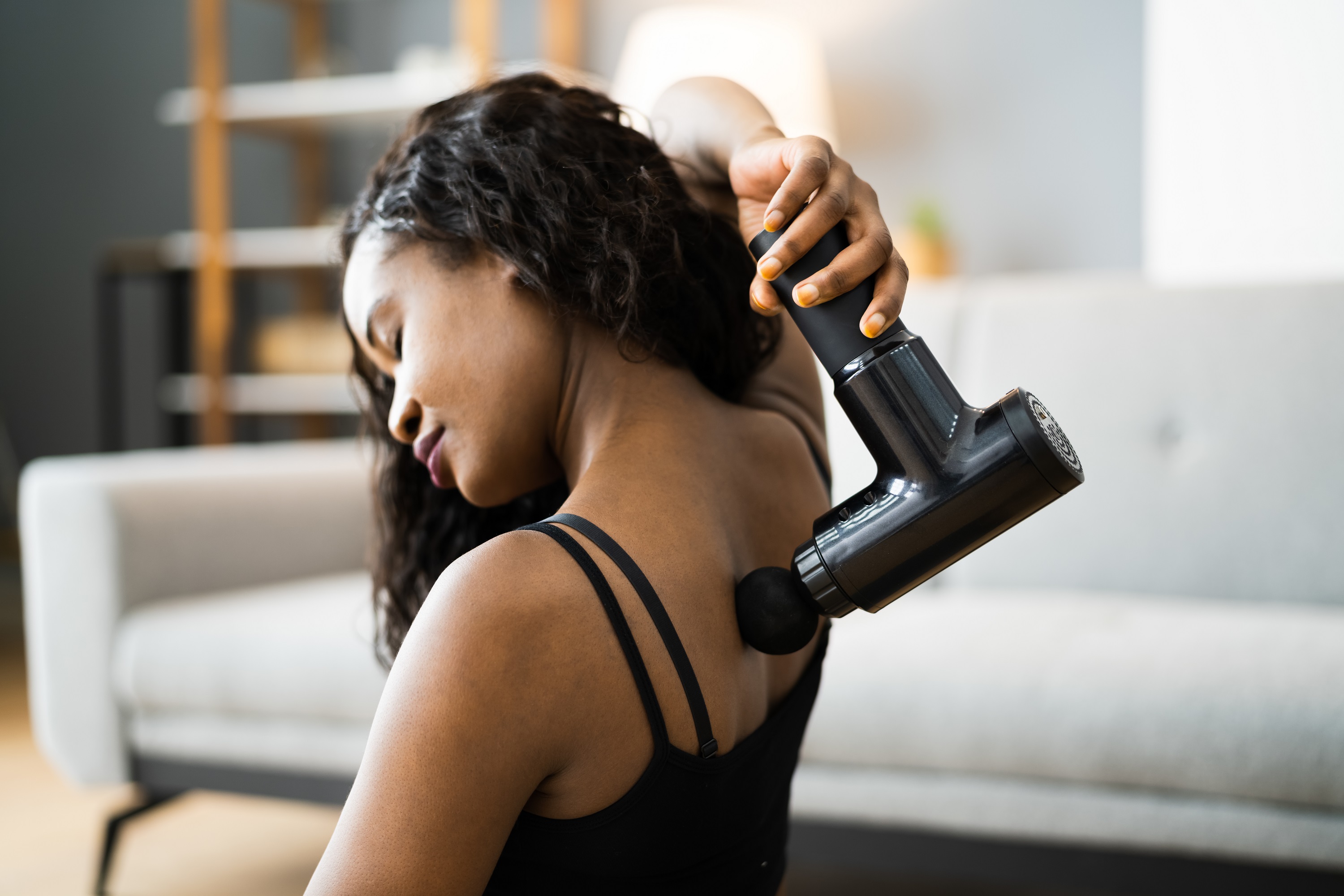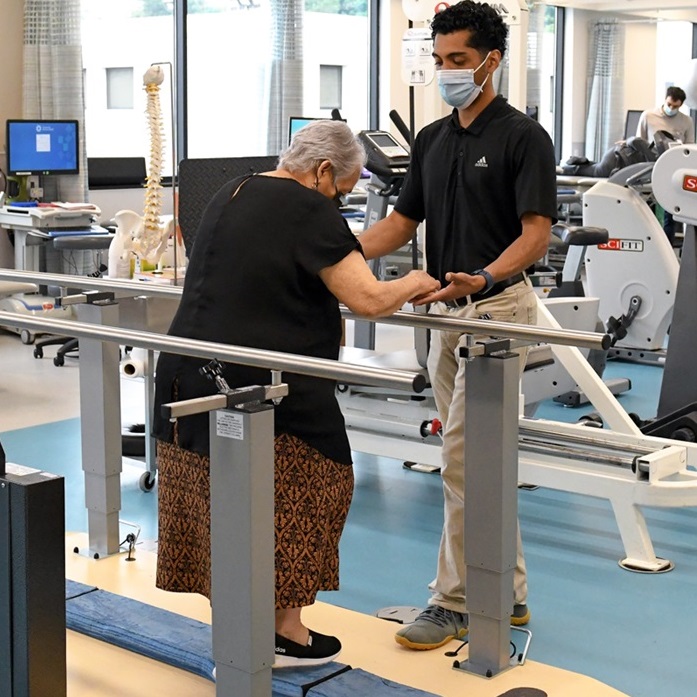Are Massage Guns Good for You? A PT Explains

April 01, 2022
At-home massage guns have been growing in popularity. Before you make the purchase, hear what a physical therapist has to say about when they can help, and when they may hurt.
“I sometimes use massage guns as a replacement for my hands to treat patients who have back pain that radiates to the leg,” says Ilyza Weiss, PT, DPT, a physical therapist at JFK Johnson Rehabilitation Institute. “They are also great for trigger points and tight muscles around the shoulders that can contribute to neck pain.”
Whether you are an athlete, recovering after an injury or just someone who is just trying to work out some aches and pains, here’s what you need to know about massage guns.
Benefits of Massage Guns
One of the most important benefits of massage guns is the ability to promote recovery after injury or intense activity by improving blood flow to the area. Precisely targeting small and large muscles with deep percussive pressure provides other recovery-related benefits, including:
- Decreasing muscle pain and tension
- Reducing lactic acid buildup that causes muscle soreness
- Improving flexibility
- Improving lymphatic flow, which helps to rid your body of toxins and support your immune system
- Improving body awareness by promoting mind-muscle connections that may improve athletic performance
How to Properly Use a Massage Gun
Massage guns can provide benefits when used on virtually all muscle groups, including quadriceps, hamstring, glute, back, biceps, tricep, calf and shoulder muscles. They can also be used in different ways, including:
- To warm up before a workout: When combined with other warm-up exercises such as dynamic stretching and cardio, using a massage gun for 30 seconds to one minute on each area you plan to target during your workout can prepare muscles by increasing blood flow and improving mobility.
- To cool down after a workout: Using a massage gun for up to one minute on each muscle group you targeted during your workout helps to maintain blood flow, which brings recovery-boosting oxygen and nutrients, reduces inflammation and promotes relaxation.
- To manage delayed-onset muscle soreness (DOMS): Using a lower setting for up to two minutes on sore muscles can provide temporary relief of DOMS.
- To relieve tight muscles: Using a massage gun for 1-2 minutes can help to relieve tight muscles after sleeping, sitting, or performing everyday tasks.
It is generally safe to use a massage gun every day for a few minutes on each targeted muscle group. To get the maximum benefits and avoid overuse, you should be sure to follow the manufacturer’s recommendations for how long and how frequently to use your massage gun. You should also monitor how your body responds to the massage gun, and stop, take a few days off or lower the amount of pressure if you are feeling any discomfort.
If you are recovering from injury or experiencing frequent muscle pain or soreness, visiting a qualified physical therapist can help you understand the root cause of your discomfort and find out if an at-home massage gun is a good choice for you.
What to Look for in a Massage Gun
If you are looking to purchase a massage gun, Ilyza said it’s important to do your research.
“Look for a massage gun with adjustable settings and interchangeable heads, which will allow you to target different muscle groups,” says Ilyza. “If more than one person will be using it, be sure it has an easy-to-clean cap, as opposed to one made of foam.”
When used properly, Ilyza said a massage gun is a great addition to just about anyone’s in-home wellness routine.
When to Skip the Massage Gun
According to Ilyza, most people can use massage guns safely at home if they follow the manufacturer’s instructions. However, it is possible to cause or worsen an injury by using a massage gun incorrectly.
“If a massage gun is causing bruising, sensitivity or discomfort, you should stop using it for a few days to allow the body to recover before trying again at a lower setting,” says Ilyza. “If discomfort persists, you should see a physician or a physical therapist.”
You should talk to your physician before using a massage gun if you:
- Take blood thinners. Blood-thinning medications may make you more likely to bruise due to pressure from a massage gun.
- Have a musculoskeletal condition. Using a massage gun could affect arthritis, osteoporosis and other musculoskeletal conditions.
- Are over the age of 65. Older adults are more likely to take medications or have health conditions that make it unsafe to use a massage gun.
Massage guns should never be used on sensitive areas, injuries, open wounds, bruises, bony areas, or joint replacements.
Next Steps & Resources:
- Learn about physical therapy at Hackensack Meridian Health.
- Meet our Experts: To make an appointment with a provider near you, call 800-822-8905 or visit our website.
The material provided through HealthU is intended to be used as general information only and should not replace the advice of your physician. Always consult your physician for individual care.
Find a doctor near me
9 Common Myths About Physical Therapy

Debunk 9 common physical therapy myths. Learn how PT helps various conditions, improves mobility, and reduces pain. JFK Johnson Rehabilitation Institute offers expert care.
When to Apply Ice Vs. Heat Packs

Learn when to use ice or heat packs for pain relief. Dr. Rama explains cold vs. heat therapy for injury and chronic pain. Get relief; call 800-822-8905.
Find a doctor near me

How to Know When Back Pain is Muscular
Understand back pain? Dr. Van Dien explains muscular causes, symptoms, and treatment. JFK Johnson Rehabilitation Institute offers care. Call 800-822-8905.

Chronic Low Back Pain Can’t Stop Metuchen Musician
Metuchen musician Jonathan Munoz overcame chronic back pain. Find relief and return to your active life. Learn more and schedule an appointment today.

Can Physical Therapy Help Your Arthritis?
Manage arthritis pain? Physical therapy may help improve mobility and range of motion. Learn more and schedule an appointment today.

